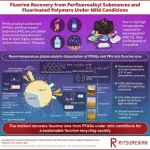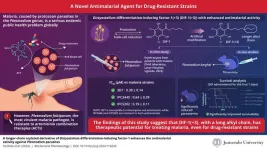(Press-News.org) A new antibiotic that works by disrupting two different cellular targets would make it 100 million times more difficult for bacteria to evolve resistance, according to new research from the University of Illinois Chicago.
For a new paper in Nature Chemical Biology, researchers probed how a class of synthetic drugs called macrolones disrupt bacterial cell function to fight infectious diseases. Their experiments demonstrate that macrolones can work two different ways – either by interfering with protein production or corrupting DNA structure.
Because bacteria would need to implement defenses to both attacks simultaneously, the researchers calculated that drug resistance is nearly impossible.
“The beauty of this antibiotic is that it kills through two different targets in bacteria,” said Alexander Mankin, distinguished professor of pharmaceutical sciences at UIC. “If the antibiotic hits both targets at the same concentration, then the bacteria lose their ability to become resistant via acquisition of random mutations in any of the two targets.”
Macrolones are synthetic antibiotics that combine the structures of two widely used antibiotics with different mechanisms. Macrolides, such as erythromycin, block the ribosome, the protein manufacturing factories of the cell. Fluoroquinolones, such as ciprofloxacin, target a bacteria-specific enzyme called DNA gyrase.
Two UIC laboratories led by Yury Polikanov, associate professor of biological sciences, and Mankin and Nora Vázquez-Laslop, research professor of pharmacy, examined the cellular activity of different macrolone drugs.
Polikanov’s group, which specializes in structural biology, studied how these drugs interact with the ribosome, finding that they bind more tightly than traditional macrolides. The macrolones were even capable of binding and blocking ribosomes from macrolide-resistant bacterial strains and failed to trigger the activation of resistance genes.
Other experiments tested whether the macrolone drugs preferentially inhibited the ribosome or the DNA gyrase enzymes at various doses. While many designs were better at blocking one target or another, one that interfered with both at its lowest effective dose stood out as the most promising candidate.
“By basically hitting two targets at the same concentration, the advantage is that you make it almost impossible for the bacteria to easily come up with a simple genetic defense,” Polikanov said.
The study also reflects the interdisciplinary collaboration at the UIC Molecular Biology Research Building, where researchers from the colleges of medicine, pharmacy and liberal arts and sciences share neighboring laboratories and drive basic science discoveries like this one, the authors said.
“The main outcome from all of this work is the understanding of how we need to go forward,” Mankin said. “And the understanding that we’re giving to chemists is that you need to optimize these macrolones to hit both targets.”
In addition to Mankin, Polikanov and Vázquez-Laslop, UIC co-authors on the paper include Elena Aleksandrova, Dorota Klepacki and Faezeh Alizadeh.
Written by Rob Mitchum
END
Dual action antibiotic could make bacterial resistance nearly impossible
2024-07-23
ELSE PRESS RELEASES FROM THIS DATE:
Salk Professor Janelle Ayres named Howard Hughes Medical Institute Investigator
2024-07-23
LA JOLLA (July 23, 2024)—Salk Professor Janelle Ayres has been selected as a 2024 Howard Hughes Medical Institute (HHMI) Investigator. The HHMI Investigators program awards established scientists with approximately $9 million in funding over seven years to pursue boundary-breaking research in their field. The honor recognizes her influential work in immunology and microbiology and its applications to the global crisis of antibiotic resistance.
Ayres is among 26 other 2024 selectees, who will join more than 250 standing Investigators—including Salk Professors ...
NLM extends commitment to LOINC with $5 million award
2024-07-23
INDIANAPOLIS -- The National Library of Medicine has awarded Regenstrief Institute a five-year, $5 million contract extension to ensure the continued maintenance, expansion and public distribution of LOINC®, a global standard for health terminology. The NLM issued its initial contract to support the creation and development of LOINC in 1999. With this extension, NLM's commitment to LOINC will reach 30 years by the time the award expires in 2029.
“The NLM’s continued support of LOINC demonstrates the value the standard delivers to patients, care providers, health ...
Light emission from nanostructures, revealed using 3D printing method for the first time
2024-07-23
Dr. Jaeyeon Pyo’s team at the Korea Electrotechnology Research Institute (KERI) has become the first in the world to reveal light emission patterns from 3D-printed nanowires, which has been published as a cover article in the prestigious scientific journal ACS Nano.
The higher resolution in display devices signifies the more of pixels in a given screen size. As pixel density increases, movies and images are displayed with greater precision and detail. In this regard, ongoing research aims to fabricate ...
HHMI invests over $300 million in 26 new investigators
2024-07-23
The Howard Hughes Medical Institute announced on July 23, 2024 that 26 of the nation’s leading scientists have been named HHMI Investigators.
Paving the way for new scientific and biomedical discoveries in fields ranging from neuroscience to immunology to structural biology, these scientists come from 19 US institutions and join HHMI’s current Investigator community, comprising more than 250 scientists.
HHMI will invest more than $300 million in this newest cohort over the next seven years, enabling each Investigator to push the boundaries of science.
“HHMI is committed to supporting visionary scientists who are pursuing discoveries that will change ...
Blood pressure high for years? Beware of stroke risk
2024-07-23
High blood pressure is known to increase a person’s chances of having a stroke.
But a study led by Michigan Medicine narrows in on the cumulative effects of years of high systolic blood pressure — the top number on the blood pressure reading and how hard the heart pumps blood to the arteries — finding that a higher average reading during adulthood is linked with a greater risk for the two most common types of stroke.
The study, published in JAMA Network Open, analyzed the average systolic blood pressure years ahead of the first stroke for more than 40,000 people ...
IMDEA Software creates FIXCHECK, a novel approach that improves automatic software repair by generating test cases revealing defects in 62% of incorrect patches
2024-07-23
IMDEA Software researchers Facundo Molina, Juan Manuel Copia and Alessandra Gorla present FIXCHECK, a novel approach to improve patch fix analysis that combines static analysis, randomized testing and large language models. Their innovations, embodied in the paper: "Improving Patch Correctness Analysis via Random Testing and Large Language Models" were presented at the International Conference on Software Testing, Verification and Validation (ICST 2024).
Context
Generating patches that fix software defects is a crucial task in the maintenance of software systems. Typically, software ...
New car smell reaches toxic levels on hot days
2024-07-23
A study of volatile organic compounds (VOCs) emitted by new cars on hot summer days finds concerning levels of formaldehyde and other aldehydes. Consumers are familiar with—and even drawn to—the “new car smell” produced as VOCs from carpets, upholstery, and other interior materials in newly manufactured passenger vehicles. These VOCs can cause a range of health effects, including headaches, inflammation of the eyes, nose and throat, fatigue, irritability, dry cough, lung disease, and disorientation. Jianyin Xiong, Shaodan Huang, and colleagues sought to capture the levels of VOCs in the passenger cabins of new cars on ...
A promising new method uses light to clean up forever chemicals
2024-07-23
Perfluoroalkyl substances (PFASs), nicknamed ‘forever chemicals,’ pose a growing environmental and health threat. Since the invention of Teflon in 1938, PFASs and perfluorinated polymers or PFs have been widely used for their exceptional stability and resistance to water and heat. These properties made them ideal for countless applications, from cookware and clothing to firefighting foam. However, this very stability has become a major problem. PFASs do not easily break down in the environment, leading ...
DIF-1(+3): Combating drug-resistant malaria parasites
2024-07-23
Malaria remains a serious health issue globally, especially in Africa. The disease is caused by protozoan parasites in the Plasmodium genus. In 2021, there were 247 million cases of malaria and 619,000 deaths reported worldwide. At present, the first line of treatment against malaria is artemisinin combination therapy (ACT) and the administration of artemisinin derivatives in combination with other drugs. After the introduction of ACTs in Africa, which accounts for more than 90% of the world’s malaria cases, the number of deaths due to malaria greatly declined in the mid-2000s. However, Plasmodium falciparum, the most virulent malaria parasite, is resistant to ACT and has been spreading ...
Can a World Cup run drive interest in a nation? New study finds evidence of the “flutie effect” off the field
2024-07-23
Nearly four decades ago, Boston College quarterback Doug Flutie launched a game-winning, mid-field touchdown pass to upset the University of Miami on the game’s final play—prompting a subsequent surge in applications to the school in what has been dubbed the “Flutie Effect.”
A team of NYU researchers has now found evidence of this effect beyond the gridiron—and athletic competition. During and after Morocco’s surprising run to the World Cup semi-finals in the fall 2022, online searches on non-sports topics related to Morocco increased ...



